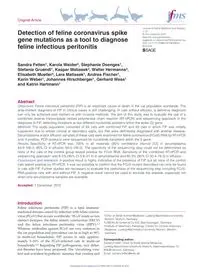
2015 Detection of feline coronavirus spike gene mutations as a tool to diagnose feline infectious peritonitis PDF
Preview 2015 Detection of feline coronavirus spike gene mutations as a tool to diagnose feline infectious peritonitis
Journal of Feline Medicine and Surgery 1–15 © The Author(s) 2015 Reprints and permissions: sagepub.co.uk/journalsPermissions.nav DOI: 10.1177/1098612X15623824 jfms.com Introduction Feline infectious peritonitis (FIP) is a fatal immune- mediated disease caused by infection with feline corona- virus (FCoV) that occurs worldwide.1 FCoV exists as two distinct biotypes, the feline enteric coronavirus (FECV) and the feline infectious peritonitis virus (FIPV).2,3 Whereas antibodies against FCoV are very common in the cat population and prevalence can be as high as 90% in multi-cat households, FIP occurs in only approxi- mately 5–10% of the FCoV-infected cats in multi-cat households.4–8 Regarding FIP pathogenesis, two differ- ent theories have been proposed. The ‘circulating viru- lent and avirulent hypothesis’ assumes that virulent and Detection of feline coronavirus spike gene mutations as a tool to diagnose feline infectious peritonitis Sandra Felten1, Karola Weider2, Stephanie Doenges1, Stefanie Gruendl1, Kaspar Matiasek3, Walter Hermanns3, Elisabeth Mueller2, Lara Matiasek1, Andrea Fischer1, Karin Weber1, Johannes Hirschberger1, Gerhard Wess1 and Katrin Hartmann1 Abstract Objectives Feline infectious peritonitis (FIP) is an important cause of death in the cat population worldwide. The ante-mortem diagnosis of FIP in clinical cases is still challenging. In cats without effusion, a definitive diagnosis can only be achieved post mortem or with invasive methods. The aim of this study was to evaluate the use of a combined reverse transcriptase nested polymerase chain reaction (RT-nPCR) and sequencing approach in the diagnosis of FIP, detecting mutations at two different nucleotide positions within the spike (S) gene. Methods The study population consisted of 64 cats with confirmed FIP and 63 cats in which FIP was initially suspected due to similar clinical or laboratory signs, but that were definitively diagnosed with another disease. Serum/plasma and/or effusion samples of these cats were examined for feline coronavirus (FCoV) RNA by RT-nPCR and, if positive, PCR products were sequenced for nucleotide transitions within the S gene. Results Specificity of RT-nPCR was 100% in all materials (95% confidence interval [CI] in serum/plasma 83.9–100.0; 95% CI in effusion 93.0–100.0). The specificity of the sequencing step could not be determined as none of the cats of the control group tested positive for FCoV RNA. Sensitivity of the ‘combined RT-nPCR and sequencing approach’ was 6.5% (95% CI 0.8–21.4) in serum/plasma and 65.3% (95% CI 50.4–78.3) in effusion. Conclusions and relevance A positive result is highly indicative of the presence of FIP, but as none of the control cats tested positive by RT-nPCR, it was not possible to confirm that the FCoV mutant described can only be found in cats with FIP. Further studies are necessary to evaluate the usefulness of the sequencing step including FCoV- RNA-positive cats with and without FIP. A negative result cannot be used to exclude the disease, especially not when only serum/plasma samples are available. Accepted: 1 December 2015 1Clinic of Small Animal Medicine, Ludwig-Maximilians-University Munich, Munich, Germany 2LABOKLIN GmbH & Co KG, Bad Kissingen, Germany 3Institute of Veterinary Pathology, Centre for Clinical Veterinary Medicine, Ludwig-Maximilians-University Munich, Munich, Germany Corresponding author: Sandra Felten, Clinic of Small Animal Medicine, Ludwig-Maximilians-University Munich, Veterinaerstrasse 13, 80539 Munich, Germany Email:
